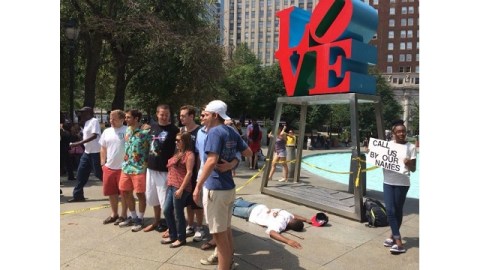The Fight for Images of Ferguson

The flood of images of violence and unrest continues to flow from Ferguson, Missouri, in the wake of the shooting death of Michael Brown on August 9, 2014. (See one slide show here.) The promise of a “post-racial America” after the election of the first African-American President seems a cruel joke when watching scenes of mostly African-American citizens square off against mostly white police and government representatives. But aside from the story that these images tell is the story of the images themselves. According to The Committee to Protect Journalists (CPJ), “Press freedom in the United States dramatically deteriorated in 2013.” A major part of that curtailed press freedom involves the primary medium of today’s information society—visual images. From arresting and threatening photojournalists to performance art specifically about picturing dead young, African-American men, the fight for images of Ferguson reveals more than we realize and more than many people want to acknowledge.
On Wednesday, August 11th, reporters Wesley Lowery of The Washington Post and Ryan J. Reilly of Huffington Post were arrested at a McDonald in Ferguson for not leaving the scene of the protest quickly enough. On Monday, August 18th, Scott Olson, a photojournalist working for photography syndicate Getty Images, found himself arrested at the same McDonald’s for the same charges. Fortunately, fellow Getty Images photographer Joe Raedlecaptured the moment that police took Olson into custody. The night before Olson’s arrest, Mustafa Hussein, a student working at a local all-volunteer radio station, tried to video and live stream the Ferguson protests when police confronted him. Hussein recorded (and posted to YouTube) an officer pointing a weapon at him and threatening, “Get the f*k out of here! You get that light off or you’re getting shot with this!” Amazingly, Hussein continued broadcasting. In addition to these individual incidents, officials requested a “no-fly zone” over Ferguson because media helicopters were allegedly interfering with their handling of the protests. From the beginning of the protests, police at different times announced illegal and undemocratic “no media allowed” policies to censor coverage of the protests and the response.
But what are these forbidden images? Certainly violence against minorities by police is something the authorities do not want documented visually for domestic and foreign consumption. (I’m sure the irony of the repressive Egyptian government condemning actions in Ferguson is lost on no one, especially the Egyptians.) Comic John Oliver insightfully and humorously laid out the serious issues surrounding the increasing militarization of U.S. police that is on full display now in Ferguson. There is pain and anger and insanity holding court in Ferguson right now and such moments bring out the “car crash” impulse in us all—that mixture of simultaneous desires to look away and to look closer.
But what are we actually seeing when we do get glimpses of Ferguson? Are the images telling us the full story? The parallels to the Civil Rights Era riots of the 1960s are obvious, as are the issues that came with the iconic photography of the violence of that time. In Seeing through Race: A Reinterpretation of Civil Rights Photography (which I reviewed here), Martin A. Berger argued photographs from the Civil Rights fights of the 1960s portrayed African-Americans as weak and incapable of saving themselves. “With great consistency,” Berger wrote, “white media outlets in the North published photographs throughout the 1960s that reduced the complex social dynamics of the civil rights movement to easily digested narratives, prominent among them white-on-black violence.” African-American media, selecting from the same pool of possible pictures, presented a different narrative that included Martin Luther King, Jr. and others as active agents in the pursuit of freedom threatening the authority of the white majority. “In order to safely move whites to either tolerate or embrace social and legislative change,” Berger concluded, “the photographs occluded various racial facts, including the agency of blacks in shaping American history and the shared beliefs of reactionary and progressive whites.” Just as Berger demonstrates that the history book version of the Civil Rights Era as told in photographs fails to tell the whole story, it’s quite likely that even the most disturbing images from Ferguson fail to capture all the nuance of the situation and instead offer two-dimensional villains and heroes.
Even Michael Brown himself has been reduced to two conflicting images: a video allegedly showing him committing a robbery unrelated to his shooting and an autopsy drawing showing where he was shot. Brown’s video paints him as sinner (as intended by the timing of its release by the authorities), whereas Brown’s autopsy schematics show him almost as saint—a sacrificial lamb opening his arms up to accept the slaughter. Either way, Michael Brown the multidimensional, humanly flawed person is lost in the exchange. Berger’s main point is that the most powerful Civil Rights Era photographs show African-Americans as passive victims with no individuality. Actor and performance artist Keith Wallace picked up on this reality in his recently enacted piece “Call Us By Our Names” (shown above). Using make-up to create the appearance of a fatal gunshot, Wallace laid face down in front of Robert Indiana’s LOVE statue in Philadelphia, Pennsylvania as tourists and others passed by, sometimes even taking pictures in front of the LOVE statue despite Wallace’s presence. “We hear about Trayvon Martin, Oscar Grant, Michael Brown. But there’s a slew of other faces and names who go unrecognized and unnamed,” Wallace says in explanation of his “Call Us By Our Names” title. “And the media is slanted in cases where the victim is of color, passing them off as thugs, or gang- and drug-related. When it’s someone who is white, they’re ‘troubled’ or ‘disturbed.’”
Wallace intentionally juxtaposes love and death in his piece: “And the irony of having a bloodied, dead body, underneath the Love statue in ‘The City of Brotherly Love’ is the play on this idea that people in America, people who look like me, historically, are perceived as being less valuable than other human beings in this country. So for me, there’s some potency in juxtaposing those kinds of images together: love and death.”
Another juxtaposition in another Philadelphia in another time—a half century ago—also says something about the fight for images of Ferguson. This summer marks the 50th anniversary of Mississippi Freedom Summer, when African-American and white activists staged a voter registration drive in Mississippi as part of the run-up to the 1964 election. When white activitsts Andrew Goodman and Michael Schwerner were killed alongside African-American activist James Chaney in Philadelphia, Mississippi by the Ku Klux Klan, a national outcry led to long-requested, but long-delayed federal intervention finally happening. But as Dave Dennis, activist organizer and trainer of the victims (and who would have been with the trio on that fatal night but for a case of bronchitis), has pointed out in interviews, he and others knew that it would take white victims to make the media take notice of what blacks had been dealing with every day. Wallace eerily echoed that sentiment when discussing the images of tourists stepping around (and sometimes over) his body: “A black dead body, laying in the middle of the street in Philadelphia, and life went on as usual. It’s an echoing of a bigger issue that we have in America: life goes on. When a black body is murdered life goes on.”
Philadelphia, Mississippi, is famous for one other thing: Ronald Reagan’s speech at the Neshoba County Fair on August 3, 1980, his first speech after accepting the Republication nomination for President. “I believe in states’ rights,” Reagan said. “I believe we have distorted the balance of our government today by giving powers that were never intended to be given in the Constitution to that federal establishment.” Critics still view Reagan’s choice of venue as a textbook case of “dog-whistle politics”—an unspoken message intended for a select audience. In that case, the unspoken message was that “states rights” equaled “business as usual” for race relations in the American South as typified by the 1964 murders. What “dog whistles” lurk beneath the images coming out of Ferguson today? Who are they meant for? How can unintended audiences hear them and respond?
Keith Wallace expected police to break up his public performance within a few minutes, but, instead, they acknowledged his right to peaceful protest and not only remained to ensure his safety, but also shook Wallace’s hand afterwards. So, perhaps there’s hope after all. Wallace’s piece reminded me of Chris Burden’s 1975 performance piece Doomed, in which he laid beneath a slanted sheet of glass beside a running wall clock until someone interacted with him. When a museum employee finally placed a pitcher of water within the dehydrated Burden’s reach after more than 45 hours, Burden smashed the glass and then the clock in a powerful statement about human compassion, or the lack thereof. The fight for images about Ferguson shouldn’t be about right and wrong but rather about human empathy and compassion, about calling people by their names and not prejudiced labels. “I am racially charged not because I want to be, but because I have to be,” Wallace eloquently puts it. “I am racially charged because I am not afforded the luxury to wander through life with my head in the (nonexistent) ‘post-racial America’ clouds. I see color because my color is seen, dismissed, devalued, and implicated as a threat everywhere I go. I am racially charged and if I make you uncomfortable by speaking out about it and calling attention to it, then I implore you to eradicate the ugliness I see every day in the world.” When we look at pictures of Ferguson we shouldn’t see others but rather ourselves in that situation. What would we do? Perhaps then we can start making sense of such tragedy and begin the process of reconciliation and change.
[Image:Keith Wallace performing “Call Us By Our Names” in front of Robert Indiana’s LOVE statue. Photo Credit: Lee Colston II.]





